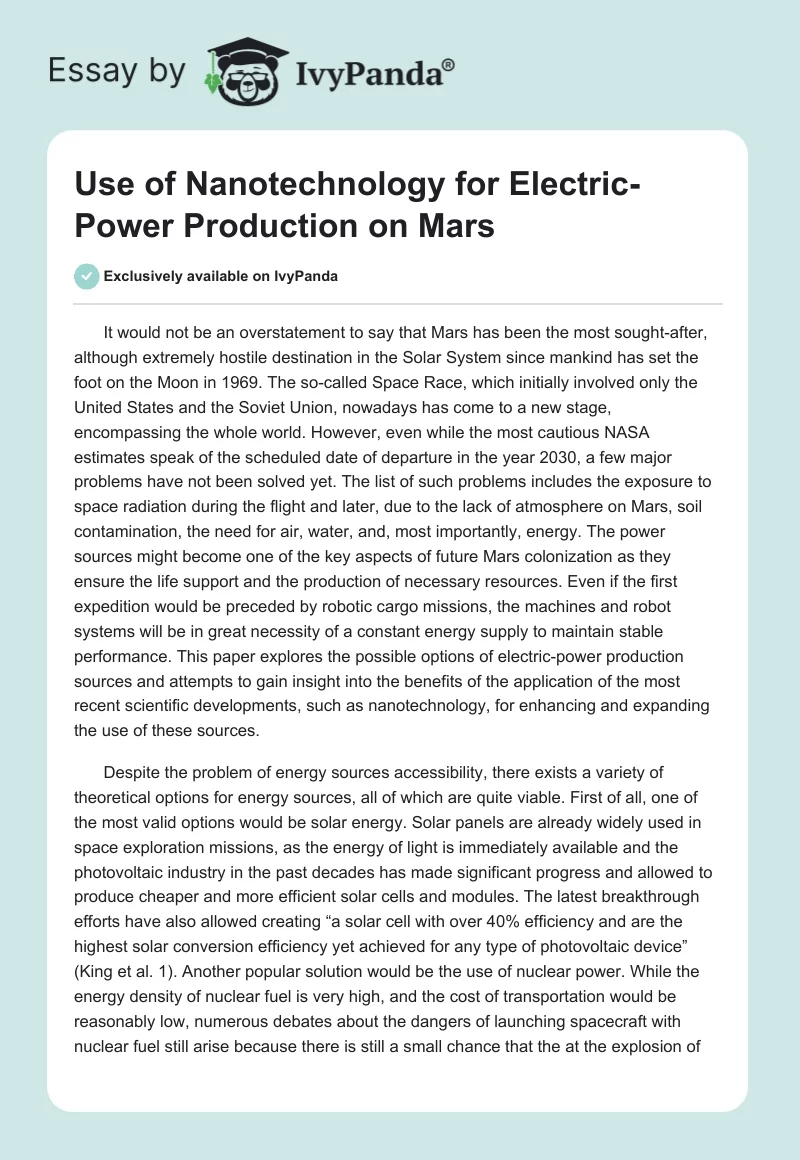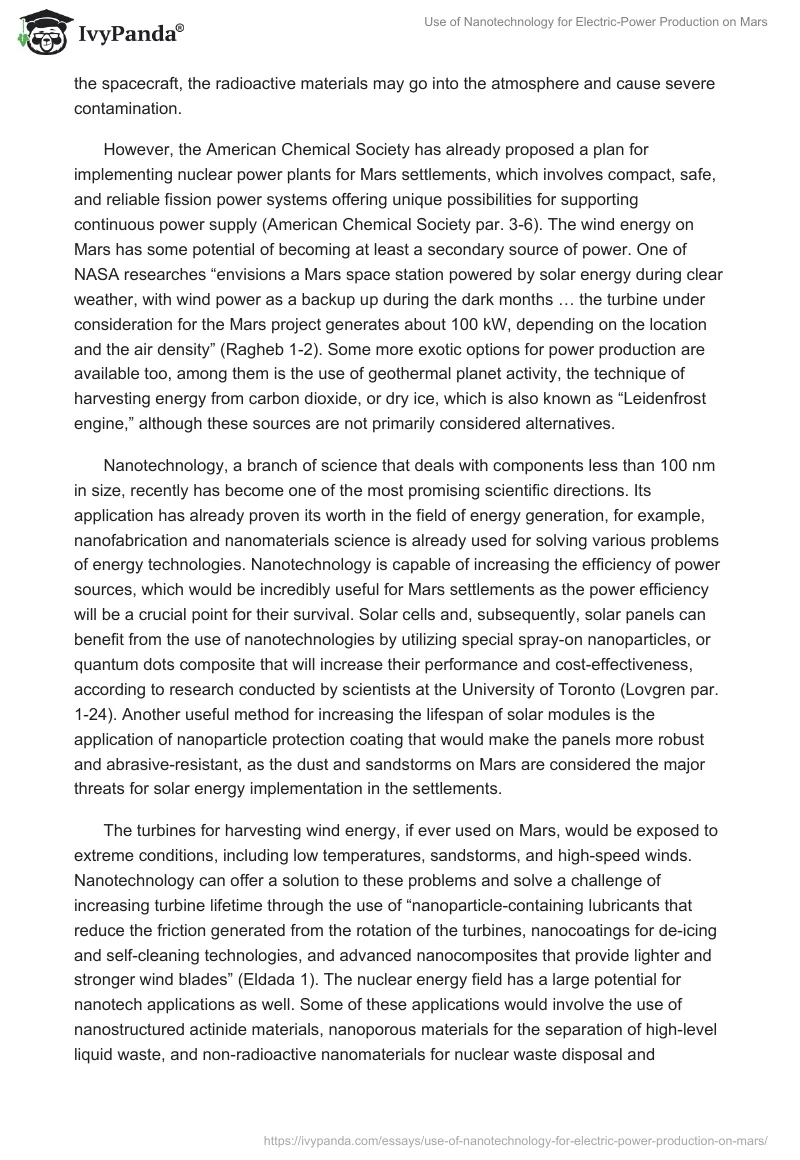It would not be an overstatement to say that Mars has been the most sought-after, although extremely hostile destination in the Solar System since mankind has set the foot on the Moon in 1969. The so-called Space Race, which initially involved only the United States and the Soviet Union, nowadays has come to a new stage, encompassing the whole world. However, even while the most cautious NASA estimates speak of the scheduled date of departure in the year 2030, a few major problems have not been solved yet. The list of such problems includes the exposure to space radiation during the flight and later, due to the lack of atmosphere on Mars, soil contamination, the need for air, water, and, most importantly, energy. The power sources might become one of the key aspects of future Mars colonization as they ensure the life support and the production of necessary resources. Even if the first expedition would be preceded by robotic cargo missions, the machines and robot systems will be in great necessity of a constant energy supply to maintain stable performance. This paper explores the possible options of electric-power production sources and attempts to gain insight into the benefits of the application of the most recent scientific developments, such as nanotechnology, for enhancing and expanding the use of these sources.
Despite the problem of energy sources accessibility, there exists a variety of theoretical options for energy sources, all of which are quite viable. First of all, one of the most valid options would be solar energy. Solar panels are already widely used in space exploration missions, as the energy of light is immediately available and the photovoltaic industry in the past decades has made significant progress and allowed to produce cheaper and more efficient solar cells and modules. The latest breakthrough efforts have also allowed creating “a solar cell with over 40% efficiency and are the highest solar conversion efficiency yet achieved for any type of photovoltaic device” (King et al. 1). Another popular solution would be the use of nuclear power. While the energy density of nuclear fuel is very high, and the cost of transportation would be reasonably low, numerous debates about the dangers of launching spacecraft with nuclear fuel still arise because there is still a small chance that the at the explosion of the spacecraft, the radioactive materials may go into the atmosphere and cause severe contamination.
However, the American Chemical Society has already proposed a plan for implementing nuclear power plants for Mars settlements, which involves compact, safe, and reliable fission power systems offering unique possibilities for supporting continuous power supply (American Chemical Society par. 3-6). The wind energy on Mars has some potential of becoming at least a secondary source of power. One of NASA researches “envisions a Mars space station powered by solar energy during clear weather, with wind power as a backup up during the dark months … the turbine under consideration for the Mars project generates about 100 kW, depending on the location and the air density” (Ragheb 1-2). Some more exotic options for power production are available too, among them is the use of geothermal planet activity, the technique of harvesting energy from carbon dioxide, or dry ice, which is also known as “Leidenfrost engine,” although these sources are not primarily considered alternatives.
Nanotechnology, a branch of science that deals with components less than 100 nm in size, recently has become one of the most promising scientific directions. Its application has already proven its worth in the field of energy generation, for example, nanofabrication and nanomaterials science is already used for solving various problems of energy technologies. Nanotechnology is capable of increasing the efficiency of power sources, which would be incredibly useful for Mars settlements as the power efficiency will be a crucial point for their survival. Solar cells and, subsequently, solar panels can benefit from the use of nanotechnologies by utilizing special spray-on nanoparticles, or quantum dots composite that will increase their performance and cost-effectiveness, according to research conducted by scientists at the University of Toronto (Lovgren par. 1-24). Another useful method for increasing the lifespan of solar modules is the application of nanoparticle protection coating that would make the panels more robust and abrasive-resistant, as the dust and sandstorms on Mars are considered the major threats for solar energy implementation in the settlements.
The turbines for harvesting wind energy, if ever used on Mars, would be exposed to extreme conditions, including low temperatures, sandstorms, and high-speed winds. Nanotechnology can offer a solution to these problems and solve a challenge of increasing turbine lifetime through the use of “nanoparticle-containing lubricants that reduce the friction generated from the rotation of the turbines, nanocoatings for de-icing and self-cleaning technologies, and advanced nanocomposites that provide lighter and stronger wind blades” (Eldada 1). The nuclear energy field has a large potential for nanotech applications as well. Some of these applications would involve the use of nanostructured actinide materials, nanoporous materials for the separation of high-level liquid waste, and non-radioactive nanomaterials for nuclear waste disposal and environmental protection (Shi et al. 727-736). Chinese researchers believe that despite being in their infancy, these technologies will become important subjects in future advanced nuclear energy systems (Shi et al. 734). Indeed, such a combination of nuclear physics, radiochemistry, and nanotechnology may lead to enhancing the efficiency and safety of nuclear fuel use and aid in solving the problem of waste disposal, which could be an immensely important issue for a future Mars colony.
Despite that idea of sending manned missions, exploration, and development of Mars territories today are no more than long-term perspectives, theoretical studies of possible planet colonization can already prove useful. First of all, such studies will help to gather data and material, which could later be used in the actual Mars missions; moreover, the empirical studies with specific, predetermined conditions could lead to several discoveries in areas that had previously been insufficiently investigated. The emergence of cross-disciplines at the intersection of different scientific fields, such as nanotechnology and clean energy sources studies, can bring significant benefits to applied science, engineering, and industry, as well as contribute to improving the quality of life. In conclusion, it should also be noted that there exists a high probability that the results of these studies would be in-demand in the nearest future because the technology develops rapidly, and private-owned companies, such as SpaceX and Blue Origin, have already made significant progress in the space industry; so, eventually, a mission to Mars could come true much sooner than it was expected.
Works Cited
American Chemical Society. The first nuclear power plants for settlements on the Moon & Mars. 2011. Web.
Eldada, Louay. “Nanotechnologies for efficient solar and wind energy harvesting and storage in smart-grid and transportation applications.” Journal Nanophoton 5.1 (2011): 051704-051704-18. Print.
King, Richard R., DC. Law, Kenneth M. Edmondson, Chris M. Fetzer, Geoffrey S. Kinsey, Heayoung Yoon, Raed A. Sherif, and NH. Karam. “40% efficient metamorphic GaInP/GaInAs/Ge multijunction solar cells.”Applied Physics Letters. 90.18 (2007): 183516-1–183516-3. Web.
Lovgren, Stefan 2005. Spray-On Solar-Power Cells Are True Breakthrough. Web.
Ragheb, Magdi 2012, Wind Power for a Mars Mission. Web.
Shi, WQ., LY. Yuan, ZJ. Li, JH. Lan, YL. Zhao, and ZF. Chai. “Nanomaterials and Nanotechnologies in Nuclear Energy Chemistry.”Radiochimica Acta 100.8-9 (2014): 727-736. Web.


